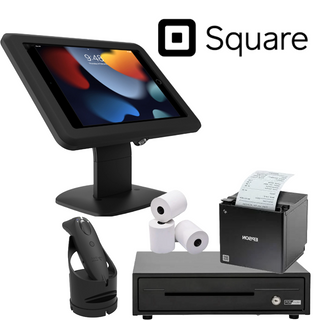All You Need to Know About Point-of-Sale (POS) Systems & How Does It Work?
If you've ever purchased at your favorite local store or dined at a restaurant, chances are you've interacted with a POS system. Today, technology plays a crucial role in streamlining business operations and enhancing customer experiences. And one of the key technological advancements that has revolutionized the way businesses handle transactions is the Point-of-Sale (POS) system.
Here, in this blog, we will unravel the intricacies of POS systems, exploring what they are, how they work, and why they are indispensable in today's business landscape.
What is Point-of-Sale (POS) Systems?
At its core, a Point-of-Sale (POS) system is a sophisticated blend of software and hardware designed to facilitate and record transactions at the moment and place where the sale occurs. Gone are the days of manual cash registers; today's POS systems are multifaceted tools that go beyond simple transaction processing. They act as the nerve center of a business, managing inventory, tracking sales, and providing valuable insights into customer behavior.
What Are the Components of a POS System?
A POS system consists of several components, both hardware and POS software, working together seamlessly to create an efficient and effective checkout experience. Let's take a closer look at each of these components:
POS Hardware Components
- Touchscreen Terminal: The central hub
where transactions take place, typically equipped with a user-friendly
touchscreen interface.
- Barcode Scanner: Used for swift and
accurate scanning of product barcodes, expediting the checkout process.
- Receipt Printer: Generates customer
receipts, documenting the details of the transaction.
- Cash Drawer: Safely stores cash, ensuring
secure and organized cash handling.
- Card Reader: Allows customers to make
electronic payments using credit or debit cards.
- Customer Display: Provides a visual representation of the transaction for the customer to review.
POS Software Components
- Sales Processing: Handles the actual
transaction, calculating totals, applying discounts, and processing various
payment methods.
- Inventory Management: Keeps track of
stock levels, automatically updating when a sale is made to prevent
over-selling.
- Reporting and Analytics: Generates
detailed reports on sales, inventory turnover, and other key metrics, aiding in
informed decision-making.
- Employee Management: Tracks employee
sales performance, hours worked, and other relevant data.
- Customer Relationship Management (CRM):
Stores customer information, enabling businesses to build and maintain
relationships through loyalty programs and targeted marketing.
How Does a POS System Work?
Now that we've identified the key POS hardware and software components, let's delve into the nuts and bolts of how Retail Point-of-Sale operates in a typical retail or hospitality setting:
Product Entry
To begin, every product in the inventory needs to be entered into the POS system. This can be done through two methods:
- Barcode Scanning: When a new product is
added to the inventory, its details, including price and description, are
linked to a unique barcode.
- Manual Entry: In cases where a product
doesn't have a barcode, the details can be manually entered into the system.
Transaction Processing
Once the products are entered into the system, the transaction processing phase begins:
- Item Selection: As a customer brings
products to the checkout, the cashier selects each item on the POS system,
either by scanning the barcode or manually entering product details.
- Total Calculation: The system calculates
the total cost based on the selected items, applying any discounts or
promotions.
Payment Handling
After the total cost is calculated, the POS system handles the payment:
- Cash Transactions: If the customer pays
with cash, the cashier opens the cash drawer and provides change if necessary.
- Card Transactions: For card payments, the
POS system interacts with the card reader to process the transaction securely.
Receipt Generation
Once the payment is processed, a receipt is generated:
- Printing or Emailing: A receipt is
generated, summarizing the transaction details. Some modern POS systems offer
the option to email receipts to customers, contributing to a more sustainable
approach.
Inventory Update
Simultaneously, the POS system updates the inventory to reflect the sale:
- Real-time Tracking: The POS system automatically updates the inventory in real-time, deducting sold items to maintain accurate stock levels.
- Reorder Alerts: When inventory levels
reach a predefined threshold, the system can generate alerts, prompting
businesses to reorder products to avoid stockouts.
Reporting and Analytics
POS systems provide valuable insights through reporting and analytics:
- Sales Reports: Business owners and
managers can access detailed sales reports, helping them identify top-selling
products, track trends, and make informed decisions.
- Employee Performance: POS systems with
integrated employee management features allow businesses to evaluate individual
performance and allocate resources effectively.
Integration with Other Systems
Point-Of-Sale systems can integrate with other business systems to streamline operations:
- Accounting Software: Many POS systems
seamlessly integrate with accounting software, streamlining financial
management processes.
- E-commerce Platforms: For businesses with an online presence, POS systems can sync with e-commerce platforms, ensuring a unified approach to inventory and sales management.
Benefits of Using a POS System
Now that we've demystified how POS systems work, let's explore the myriad benefits they bring to businesses:
Efficiency and Speed: They significantly reduce the time it takes to process transactions, leading to shorter queues and happier customers.
Accurate Inventory Management: Real-time inventory tracking minimizes the risk of stockouts or overstocking, optimizing supply chain management.
Enhanced Customer Experience: Quick and seamless transactions contribute to an overall positive customer experience, fostering loyalty.
Data-Driven Decision Making: Comprehensive reporting and analytics empower businesses to make informed decisions, adapting to market trends and customer preferences.
Improved Security: Secure payment processing and the ability to track transactions reduce the risk of theft and fraud.
Streamlined Operations: POS systems automate mundane tasks, allowing businesses to focus on core operations and strategic planning.
Final Words
Overall, Point-of-Sale Technology is the unsung heroes of modern commerce, seamlessly facilitating transactions, managing inventory, and providing invaluable insights. As technology continues to evolve, so too will POS systems, playing an integral role in shaping the future of retail and hospitality. Whether you're a small local business or a large enterprise, embracing the power of a robust POS system can undoubtedly elevate your business operations and contribute to sustained success in today's dynamic business landscape.






























